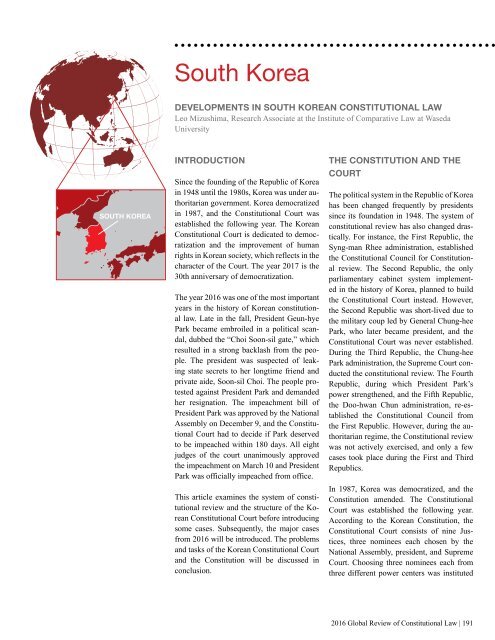2016 Global Review of Constitutional Law
I-CONnect–Clough Center collaboration.
I-CONnect–Clough Center collaboration.
You also want an ePaper? Increase the reach of your titles
YUMPU automatically turns print PDFs into web optimized ePapers that Google loves.
South Korea<br />
DEVELOPMENTS IN SOUTH KOREAN CONSTITUTIONAL LAW<br />
Leo Mizushima, Research Associate at the Institute <strong>of</strong> Comparative <strong>Law</strong> at Waseda<br />
University<br />
SOUTH KOREA<br />
INTRODUCTION<br />
Since the founding <strong>of</strong> the Republic <strong>of</strong> Korea<br />
in 1948 until the 1980s, Korea was under authoritarian<br />
government. Korea democratized<br />
in 1987, and the <strong>Constitutional</strong> Court was<br />
established the following year. The Korean<br />
<strong>Constitutional</strong> Court is dedicated to democratization<br />
and the improvement <strong>of</strong> human<br />
rights in Korean society, which reflects in the<br />
character <strong>of</strong> the Court. The year 2017 is the<br />
30th anniversary <strong>of</strong> democratization.<br />
The year <strong>2016</strong> was one <strong>of</strong> the most important<br />
years in the history <strong>of</strong> Korean constitutional<br />
law. Late in the fall, President Geun-hye<br />
Park became embroiled in a political scandal,<br />
dubbed the “Choi Soon-sil gate,” which<br />
resulted in a strong backlash from the people.<br />
The president was suspected <strong>of</strong> leaking<br />
state secrets to her longtime friend and<br />
private aide, Soon-sil Choi. The people protested<br />
against President Park and demanded<br />
her resignation. The impeachment bill <strong>of</strong><br />
President Park was approved by the National<br />
Assembly on December 9, and the <strong>Constitutional</strong><br />
Court had to decide if Park deserved<br />
to be impeached within 180 days. All eight<br />
judges <strong>of</strong> the court unanimously approved<br />
the impeachment on March 10 and President<br />
Park was <strong>of</strong>ficially impeached from <strong>of</strong>fice.<br />
This article examines the system <strong>of</strong> constitutional<br />
review and the structure <strong>of</strong> the Korean<br />
<strong>Constitutional</strong> Court before introducing<br />
some cases. Subsequently, the major cases<br />
from <strong>2016</strong> will be introduced. The problems<br />
and tasks <strong>of</strong> the Korean <strong>Constitutional</strong> Court<br />
and the Constitution will be discussed in<br />
conclusion.<br />
THE CONSTITUTION AND THE<br />
COURT<br />
The political system in the Republic <strong>of</strong> Korea<br />
has been changed frequently by presidents<br />
since its foundation in 1948. The system <strong>of</strong><br />
constitutional review has also changed drastically.<br />
For instance, the First Republic, the<br />
Syng-man Rhee administration, established<br />
the <strong>Constitutional</strong> Council for <strong>Constitutional</strong><br />
review. The Second Republic, the only<br />
parliamentary cabinet system implemented<br />
in the history <strong>of</strong> Korea, planned to build<br />
the <strong>Constitutional</strong> Court instead. However,<br />
the Second Republic was short-lived due to<br />
the military coup led by General Chung-hee<br />
Park, who later became president, and the<br />
<strong>Constitutional</strong> Court was never established.<br />
During the Third Republic, the Chung-hee<br />
Park administration, the Supreme Court conducted<br />
the constitutional review. The Fourth<br />
Republic, during which President Park’s<br />
power strengthened, and the Fifth Republic,<br />
the Doo-hwan Chun administration, re-established<br />
the <strong>Constitutional</strong> Council from<br />
the First Republic. However, during the authoritarian<br />
regime, the <strong>Constitutional</strong> review<br />
was not actively exercised, and only a few<br />
cases took place during the First and Third<br />
Republics.<br />
In 1987, Korea was democratized, and the<br />
Constitution amended. The <strong>Constitutional</strong><br />
Court was established the following year.<br />
According to the Korean Constitution, the<br />
<strong>Constitutional</strong> Court consists <strong>of</strong> nine Justices,<br />
three nominees each chosen by the<br />
National Assembly, president, and Supreme<br />
Court. Choosing three nominees each from<br />
three different power centers was instituted<br />
<strong>2016</strong> <strong>Global</strong> <strong>Review</strong> <strong>of</strong> <strong>Constitutional</strong> <strong>Law</strong> | 191


